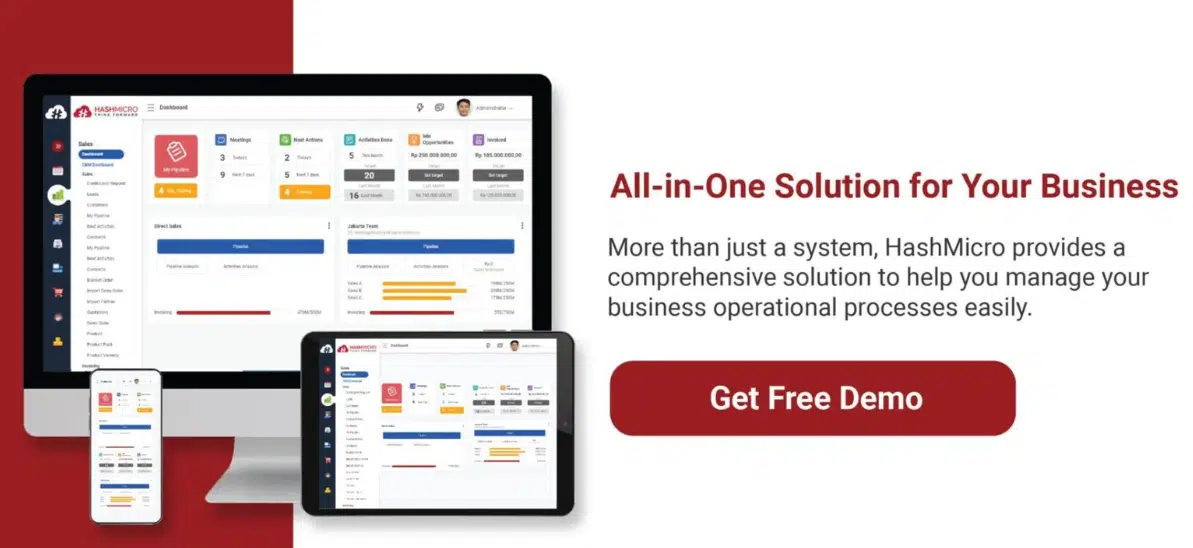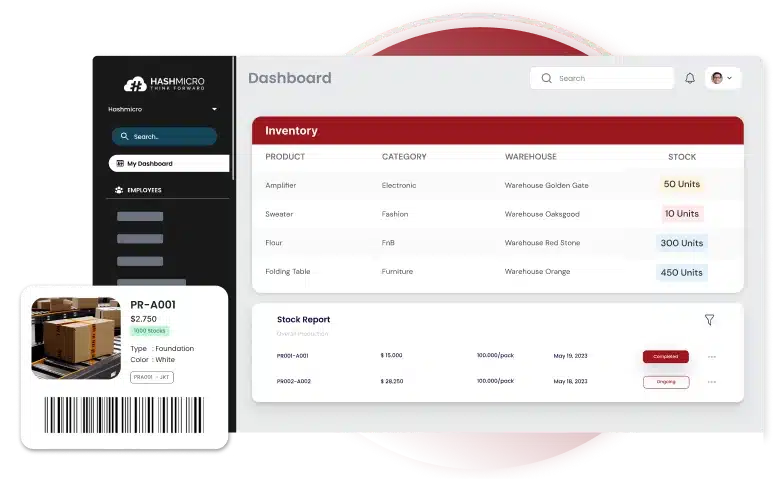One of the most common problems businesses face is inefficient inventory management. Manual tracking, delayed stock updates, and unexpected stockouts can disrupt operations and result in financial losses. What if you could quickly eliminate these issues and achieve real-time inventory accuracy?
The perpetual inventory system offers a transformative approach to inventory management by providing real-time updates whenever stock moves. HashMicro Inventory Management Software provides solutions with advanced features such as Barcode Management, Lot and Serial Number Tracking, Inventory Forecasting, and Stock Aging Analysis, designed to automate processes and integrate inventory tracking into business operations.
In this article, we’ll discuss the perpetual inventory system’s key advantages and pitfalls and demonstrate how the HashMicro Inventory System can be the ultimate solution for your business needs.
Key Takeaways
|
Table of Content:
Table of Content
What is Perpetual Inventory System?
A perpetual inventory system is a real-time method of tracking stock levels using tools like barcode scanners, point-of-sale (POS) systems, and inventory software. Every time you sell, restock, or adjust inventory, the system updates automatically. This eliminates the need for manual stock counts and ensures you always have an accurate view of your inventory.
For business owners and managers, this means no more guessing about stock levels or dealing with costly errors. With perpetual inventory, you can avoid stockouts, reduce overstocking, and make smarter purchasing decisions. It’s a game-changer for businesses with fast-moving inventory, like retail stores and manufacturers, helping you stay efficient and ahead of the competition.
Hashy AI Fact

Need to Know
AI automates inventory management, improving visibility and control. AI for Inventory Management enables accurate demand forecasting, tracks stock levels in real time, and minimizes excess or shortage, helping businesses reduce holding costs and improve fulfillment speed.
Request a free demo today!
How Perpetual Inventory Works in Real-Time
A perpetual inventory system updates your stock automatically every time you make a sale, receive new stock, or adjust inventory. Tools like barcode scanners, POS systems, and inventory software handle the updates instantly, so you always know exactly what’s in stock.
Here’s how it works:
- Sales: When an item is sold, the system deducts it from inventory immediately.
- Restocking: New stock is scanned and added to the system on arrival.
- Adjustments: Any changes, like returns or damages, are logged in real-time.
This real-time tracking ensures accurate inventory levels, helping you avoid stockouts or overstocking and making it easier to manage your business efficiently.
The Benefits: Why Businesses Prefer Perpetual Systems
You need to know that outstanding inventory management has become the basis for decision-making in the company. Usually, companies record inventory using the perpetual method. However, using this method requires companies to update their inventory data continuously. That is why an inventory management software is needed to avoid manual work and streamline the process.
A perpetual inventory system is a solution that updates inventory levels in your warehouse continuously, quickly, and accurately. Implementing the best perpetual inventory system offers several advantages. Here are four key benefits:
1. Real-Time updates
The first advantage is real-time updates. You must always update inventory data in the company. That is why you must always update inventory data on an ongoing basis by implementing the latest inventory system. In addition, this system can automate and track purchases and sales instantly. You can also access inventory data whenever and wherever you need it.
Using a cloud based inventory system ensures that all updates are synchronized in real-time across different devices and locations.
2. More Informed Forecasting
By using a perpetual inventory system, you can understand your customers’ buying patterns. This system will assist you in finding new opportunities that can maximize the company’s sales strategy. By knowing customer buying patterns, you can prepare the stock you need as best as possible. In addition, this system will prevent you from excess or shortage of stock that can result in company losses.
3. Managing Multiple Locations Easily
One of the challenges in inventory is how to monitor inventory at various locations as effectively and efficiently as possible. You will be overwhelmed if you do manual inventory monitoring. Manual monitoring will only waste a lot of time and effort. Therefore, the inventory system is here to manage multiple inventories in all locations easily. That way, you can track the inventory levels of all outlets quickly and efficiently. In addition, you can also find out the supply needs of each outlet, thus avoiding stock shortages.
4. Facilitates Preparation of Financial Statements
Finally, the last advantage you will get from the inventory system is the ease of preparing financial reports. You need to understand that one of the components of financial statements is inventory value. Therefore, this system can speed up your preparation of financial reports. This is because the amount and value of the available stock are recorded directly in the system. That way, you can avoid errors in manual calculations.
The Drawbacks: Challenges You Need to Know
Although the inventory system has many advantages, there are several things you need to pay attention to. By knowing the shortcomings in the system, you can avoid and anticipate these problems. But you need to note that the benefits of this system are very large for your company. Therefore, don’t hesitate to apply the best perpetual inventory system to your business. Here are the disadvantages of a perpetual inventory system that you must pay attention to:
1. Loss of items
The first disadvantage is the vulnerability to loss of items. This system does have a function to ensure quick and easy inventory recording. However, the absence of physical checks in this system has the potential for the loss of goods and can result in company losses.
2. Scanning errors
One of the important things that must be in a perpetual inventory system is that each item must have a barcode. The presence of a barcode or tag on each item is used to make it easier for you to scan all items. Suppose an error occurs in the scanning system or fails to be detected. In that case, the company will not record the item in the system.
3. Improper inventory tracking
The main problem in the inventory system is improper inventory tracking. If this happens, tracking the company’s goods and inventory in the warehouse or store will hamper your business operations. Therefore, you can use effective and efficient backups to support recording in the perpetual inventory system.
4. Hacking
One of the things you need to be aware of when it comes to systems is hacking. Irresponsible hacking will threaten the security of all company data and information. This also applies to the perpetual inventory system in your company. Therefore, you should make sure to protect company data securely. The existence of hacking can result in the leakage of company data. If this happens, your company will be considered to have no credibility and the system is not optimal.
5. Theft
The last weakness is that it is vulnerable to theft. A perpetual inventory system does not guarantee that the stock of goods in your company will remain safe from theft. The possibility of theft by irresponsible people is still very large. Therefore, companies must implement strict procedures to prevent theft, which can harm the company. If items are lost due to theft, this will impact your records in the perpetual inventory system.
Also read: Top Inventory Management Software Systems in Singapore
Perpetual vs. Periodic Inventory: Key Differences Explained
The perpetual inventory system and periodic inventory system are two common methods for managing stock, but they differ significantly in how they track and update inventory data. Here’s are key differences between perpetual and periodic inventory:
| Aspects | Perpetual Inventory System | Periodic Inventory System |
| Stock Management | Continuously updated inventory levels in real time. | Relies on manual stock counts conducted at specific intervals, such as monthly, or annually. |
| Accuracy | Provides a constant view of stock levels, making it easier to avoid stockouts or overstocking. | Can lead to discrepancies, as inventory changes between counts may not be accounted for. |
| Cost | Higher initial costs due to the need for technology like barcode scanners and inventory management software. | Lower initial costs, as it relies on periodic physical counts without the need for advanced technology. |
Choosing the right method depends on your business needs. If you manage high volumes of transactions or need precise stock data for decision-making, the perpetual system is ideal. However, if you run a smaller operation with less frequent inventory changes, the periodic system may be a practical and budget-friendly option.
Is a Perpetual Inventory System Right for Your Business?
Now that you know the perpetual inventory system’s advantages and disadvantages will help you choose when to put it into practice. So, when should a perpetual inventory system be used? You must put this method in place if you want to grow your business.
Additionally, you should be aware of the size of the company’s goods and products as well as its profit margins. As a result, you may quickly make your business inventory-based. To build the most sophisticated inventory management software in the business, you must also make sure the vendor is the proper one.
The top suppliers assist you and assist in resolving workplace issues. To choose the finest inventory system, you may also speak with the top providers. To choose the right moment to adopt this system, you may also consult with the top inventory system suppliers.
Also Read: Best ERP Software in Singapore
Conclusion
Tracking inventory in real-time is crucial for businesses looking to stay ahead of the competition, and the Perpetual Inventory System offers just that. With continuous updates, this system provides an accurate view of stock levels, eliminating the risk of stockouts or overstocking. By automatically adjusting inventory records with each sale or purchase, it helps maintain precise data, ensuring that your business can meet customer demands without delay.
While the Perpetual Inventory System has its advantages, such as real-time tracking and improved decision-making, it’s essential to consider the challenges like setup costs and system maintenance. However, with the right ERP system in place, these concerns can be easily managed.
If you’re ready to implement an inventory management software that delivers real-time updates and reduces manual errors, HashMicro’s Perpetual Inventory System is the right choice for your business. Try it for free today and experience how it can help optimize your inventory management and drive business growth!

FAQ about Perpetual Inventory System
-
What is the difference between perpetual and periodic inventory system?
A perpetual inventory system is constantly updated as each sale / order happens; AKA perpetually updating the data. A periodic inventory system is updated manually after each accounting period; AKA periodically updating the data.
-
Does perpetual inventory use Lifo or FIFO?
In a perpetual inventory system, cost flow assumptions like FIFO (First-In, First-Out), LIFO (Last-In, First-Out), and average cost are essential for tracking. FIFO sells the oldest inventory first, impacting COGS with older prices, while LIFO sells the newest inventory first, reflecting newer prices in COGS.
-
How does a perpetual inventory system work?
Perpetual inventory is a continuous accounting practice that records inventory changes in real-time, without the need for physical inventory, so the book inventory accurately shows the real stock.



























































